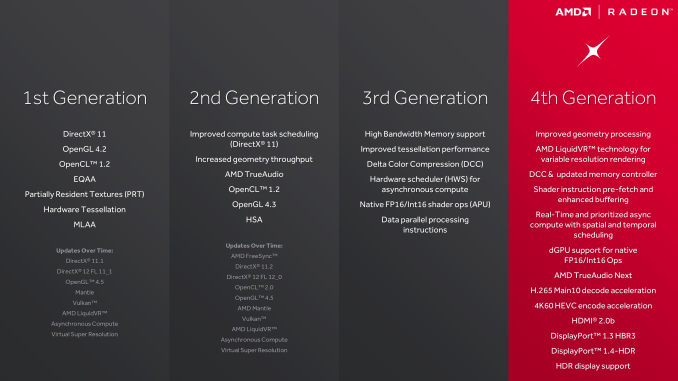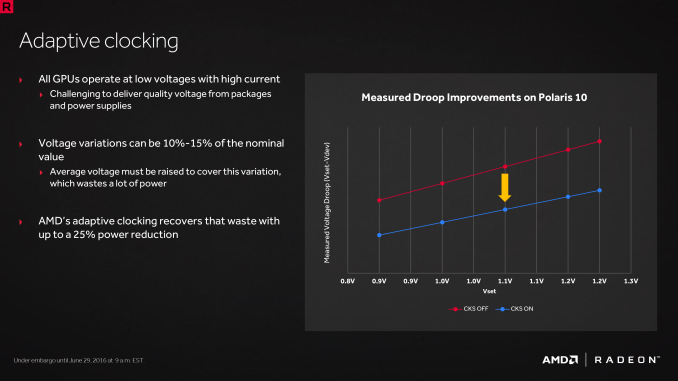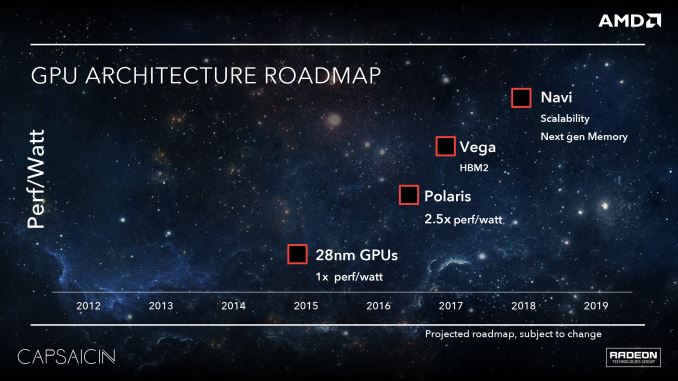The AMD Radeon RX 480 Preview: Polaris Makes Its Mainstream Mark
by Ryan Smith on June 29, 2016 9:00 AM ESTAMD's Path to Polaris
With the benefit of hindsight, I think in reflection that the 28nm generation started out better for AMD than it ended. The first Graphics Core Next card, Radeon HD 7970, had the advantage of launching more than a quarter before NVIDIA’s competing Kepler cards. And while AMD trailed in power efficiency from the start, at least for a time there they could compete for the top spot in the market with products such as the Radeon HD 7970 GHz Edition, before NVIDIA rolled out their largest Kepler GPUs.
However I think where things really went off of the rails for AMD was mid-cycle, in 2014, when NVIDIA unveiled the Maxwell architecture. Kepler was good, but Maxwell was great; NVIDIA further improved their architectural and energy efficiency (at times immensely so), and this put AMD on the back foot for the rest of the generation. AMD had performant parts from the bottom R7 360 right up to the top Fury X, but they were never in a position to catch Maxwell’s efficiency, a quality that proved to resonate with both reviewers and gamers.
The lessons of the 28nm generation were not lost on AMD. Graphics Core Next was a solid architecture and opened the door to AMD in a number of ways, but the Radeon brand does not exist in a vacuum, and it needs to compete with the more successful NVIDIA. At the same time AMD is nothing if not scrappy, and they can surprise us when we least expect it. But sometimes the only way to learn is the hard way, and for AMD I think the latter half of the 28nm generation was for the Radeon Technologies Group learning the hard way.
So what lessons did AMD learn for Polaris? First and foremost, power efficiency matters. It matters quite a lot in fact. Every vendor – be it AMD, Intel, or NVIDIA – will play up their strongest attributes. But power efficiency caught on with consumers, more so than any other “feature” in the 28nm generation. Though its importance in the desktop market is forum argument fodder to this day, power efficiency and overall performance are two sides of the same coin. There are practical limits for how much power can be dissipated in different card form factors, so the greater the efficiency, the greater the performance at a specific form factor. This aspect is even more important in the notebook space, where GPUs are at the mercy of limited cooling and there is a hard ceiling on heat dissipation.
As a result a significant amount of the work that has gone into Polaris has been into improving power efficiency. To be blunt, AMD has to be able to better compete with NVIDIA here, but AMD’s position is more nuanced than simply beating NVIDIA. AMD largely missed the boat on notebooks in the last generation, and they don’t want to repeat their mistakes. At the same time, starting now with an energy efficient architecture means that when they scale up and scale out with bigger and faster chips, they have a solid base to work from, and ultimately, more chances to achieve better performance.
The other lesson AMD learned for Polaris is that market share matters. This is not an end-user problem – AMD’s market share doesn’t change the performance or value of their cards – but we can’t talk about what led to Polaris without addressing it. AMD’s share of the consumer GPU market is about as low as it ever has been; this translates not only into weaker sales, but it undermines AMD’s position as a whole. Consumers are more likely to buy what’s safe, and OEMs aren’t much different, never mind the psychological aspects of the bandwagon effect.
Consequently, with Polaris AMD made the decision to start with the mainstream market and then work up from there, a significant departure from the traditional top-down GPU rollouts. This means developing chips like Polaris 10 and 11 first, targeting mainstream desktops and laptops, and letting the larger enthusiast class GPUs follow. The potential payoff for AMD here is that this is the opposite of what NVIDIA has done, and that means AMD gets to go after the high volume mainstream market first while NVIDIA builds down. Should everything go according to plan, then this gives AMD the opportunity to grow out their market share, and ultimately shore up their business.
As we dive into Polaris, its abilities, and its performance, it’s these two lessons we’ll see crop up time and time again, as these were some of the guiding lessons in Polaris’s design. AMD has taken the lessons of the 28nm generation to heart and have crafted a plan to move forward with the FinFET generation, charting a different, and hopefully more successful path.
Though with this talk of energy efficiency and mainstream GPUs, let’s be clear here: this isn’t AMD’s small die strategy reborn. AMD has already announced their Vega architecture, which will follow up on the work done by Polaris. Though not explicitly stated by AMD, it has been strongly hinted at that these are the higher performance chips that in past generations we’d see AMD launch with first, offering performance features such as HBM2. AMD will have to live with the fact that for the near future they have no shot at the performance crown – and the halo effect that comes with it – but with any luck, it will put AMD in a better position to strike at the high-end market once Vega’s time does come.













449 Comments
View All Comments
Hurn - Thursday, June 30, 2016 - link
The real question, here, is why the R9 380 beats the pants off of the R9 380X in many tests.Example: Dirt Rally 1920x1080 Ultra Quality. The 380 gets 64.3, while the 380X only gets 33.1. Half the speed from a card that's supposed to be faster?? Investigation needed!
Ryan Smith - Friday, July 1, 2016 - link
Thanks.It looks like I errored when transcribing the results into the database. I've gone through and corrected the charts.
Archie2085 - Friday, July 1, 2016 - link
@Ryan Any possibility you can cover whats leakage on this process . Lower Temps leading to lower power draw without reducing clocks??? either changing coolers or lowering ambient temp by blowing cold air??Been seeing posts of disproportionate increase in temps and powerdraw
FourEyedGeek - Thursday, June 30, 2016 - link
I'll wait to RX 490.Locut0s - Friday, July 1, 2016 - link
So I guess like the 1080 this will be a "preview" that we will never get an actual review of.pencea - Friday, July 1, 2016 - link
Yup exactly.Anand still hasn't done a review of both GTX 1070 or 1080, and now the 480. While other major sites have already done both reference and custom reviews, along with SLI testing on the Nvidia cards.
Unacceptable for a site like this.
X-Alt - Friday, July 1, 2016 - link
Let's look at it this way2900XT->7970->R9 290X->Fury X-???
6970->7950->R9 290->Fury Nano\390X->???
6950->7870->R9 280X->R9 380X->RX480
6870->7850->R9 270X->R9 380->??
All that matters is how the 1060 stacks up
dani_dacota - Friday, July 1, 2016 - link
Ryan, did you have a separate 4GB card to test or did you switch the vram config in the bios. Reason I ask is because I am wondering if the extra 4GB of vram might be pushing the RX 480 to post power consumption figures as high as the 970 even though the gpu chip itself is more efficient. If the extra 4GB of vram consumes 15-20W of power itself than the power efficiency numbers might improve significantly compared to the 970.FreeKill - Friday, July 1, 2016 - link
*Wondering what year we'll get the REAL full version of this GPU as a re-badge* I completely understand chip harvesting to sell the highest percentage of chips out of a fab, But I can't help but be pissed off with AMD about advertising to everyone that this is a fully enabled chip as I highly doubt it is, I believe it has 40 CU's and 2560 SP's and is currently neutered in order to hit their marketing points (power, price) They've done this with virtually every newly released GPU for years now so I should be used to it but time will tell if suddenly there's a 40 CU, GDDR5X Polaris based card in 12 months badged as a 570. I think Tahiti (7970) and Fiji (Fury X) are the only two GPU's they haven't neutered and lied about from day 1Several examples:
Tonga:
http://www.kitguru.net/components/graphic-cards/an...
Hawaii:
http://forums.guru3d.com/showthread.php?t=385046
Tams80 - Saturday, July 2, 2016 - link
I don't understand your issues with this, other than perhaps a concern for wasting natural resources.As long as AMD provide what they claim to, at the price they state; then what is the issue? Sure, they could make something better, but that is not the market they have targeted with this product.